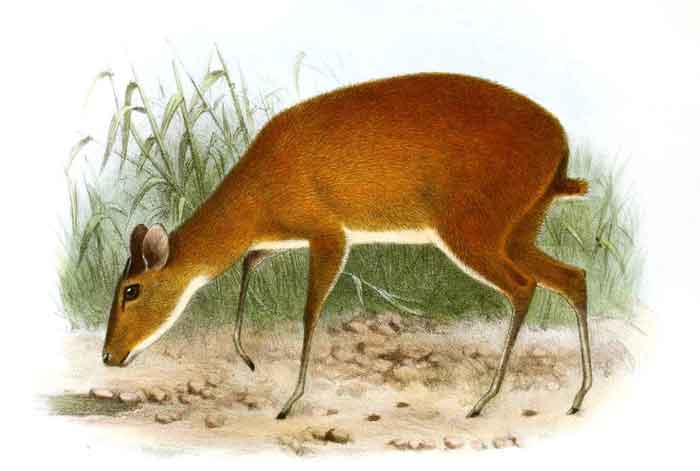
Superregnum: Eukaryota
Cladus: Unikonta
Cladus: Opisthokonta
Cladus: Holozoa
Regnum: Animalia
Subregnum: Eumetazoa
Cladus: Bilateria
Cladus: Nephrozoa
Superphylum: Deuterostomia
Phylum: Chordata
Subphylum: Vertebrata
Infraphylum: Gnathostomata
Megaclassis: Osteichthyes
Cladus: Sarcopterygii
Cladus: Rhipidistia
Cladus: Tetrapodomorpha
Cladus: Eotetrapodiformes
Cladus: Elpistostegalia
Superclassis: Tetrapoda
Cladus: Reptiliomorpha
Cladus: Amniota
Cladus: Synapsida
Cladus: Eupelycosauria
Cladus: Sphenacodontia
Cladus: Sphenacodontoidea
Cladus: Therapsida
Cladus: Theriodontia
Cladus: Cynodontia
Cladus: Eucynodontia
Cladus: Probainognathia
Cladus: Prozostrodontia
Cladus: Mammaliaformes
Classis: Mammalia
Subclassis: Trechnotheria
Infraclassis: Zatheria
Supercohors: Theria
Cohors: Eutheria
Infraclassis: Placentalia
Cladus: Boreoeutheria
Superordo: Laurasiatheria
Cladus: Scrotifera
Cladus: Ferungulata
Cladus: Euungulata
Ordo: Artiodactyla
Cladus: Artiofabula
Cladus: Cetruminantia
Subordo: Ruminantia
Cladus: Pecora
Superfamilia: Bovoidea
Familia: Bovidae
Subfamilia: Antilopinae
Genus: Nesotragus
Species: Nesotragus batesi
Name
Nesotragus batesi (De Winton, 1903)
Type locality: "Efulen, Bulu Country, Kamarun, 1500 ft. above sea"; Cameroon
Synonymy
Neotragus batesi De Winton, 1903: 193 [Protonym]
Nesotragus batesi (De Winton, 1903)
Eponymy: G. L. Bates: [De Winton, 1903: 192]
References
Primary references
de Winton, W.E. 1903. On a new Species of Pigmy Antelope of the Genus Neotragus from the Cameroons District, W. Africa. Proceedings of the Zoological Society of London I(2): 192–194. BHL Reference page.
Links
Neotragus batesi in Mammal Species of the World.
Wilson, Don E. & Reeder, DeeAnn M. (Editors) 2005. Mammal Species of the World – A Taxonomic and Geographic Reference. Third edition. ISBN 0-8018-8221-4.
IUCN: Neotragus batesi de Winton, 1903 (Least Concern)
Vernacular names
English: Bates' Pygmy Antelope
español: Antílope pigmeo de Bates
suomi: Pikkuantilooppi
magyar: Bates-törpeantilop
svenska: Bates dvärgantilop
Bates's pygmy antelope (Nesotragus batesi), also known as the dwarf antelope, pygmy antelope[2] or Bates' dwarf antelope, is a very small antelope living in the moist forest and brush of Central and West Africa. It is in the same genus as the suni.
Description
Adult antelope weigh about 2 to 3 kg (4.4 to 6.6 lb), and are 50 to 57 cm (20 to 22 in) long, with a tail length of 4.5 to 5.0 cm (1.8 to 2.0 in). Only males have horns, about 3.8 to 5.0 cm (1.5 to 2.0 in) long. Their coat is shiny dark chestnut on the back and lighter toward the flanks. Male antelope are generously bigger than females.[3]
Distribution and habitat
Bates pigmy antelope is native to tropical Central Africa. The range is separated into three distinct areas; southeastern Nigeria; the lower part of the Congo Basin; and northeastern Democratic Republic of Congo extending into western Uganda. Its typical habitat is humid lowland forest where it favours dense undergrowth. It also inhabits plantations, secondary forest, cleared areas and areas round human habitations.[1]
Ecology
Bates's pygmy antelope eat leaves, buds, shoots, fungus, grass, and herbs. They also eat crops, which makes them unpopular with farmers. They are often caught in snares near agricultural fields. They have a typical territory of 2 to 4 ha (4.9 to 9.9 acres). Males are territorial, marking their territory with scent produced in the preorbital glands. Females are friendlier with each other and sometimes live in small groups. They bark when fleeing. Most pygmy antelope mate at late dry and early wet seasons. Gestation period is 180 days. One young is born per pregnancy. The fawn weighs between 1.6 and 2.4 kg (3.5 and 5.3 lb).[3]
Status
Bates's pygmy antelope are not endangered although they are facing habitat loss; the expansion of human population has a negative effect on future population. In general, they are able to adapt to secondary forest, plantations, roadside verges and village gardens. Although not hunted commercially, this antelope is hunted for bushmeat in limited numbers.[1]
References
IUCN SSC Antelope Specialist Group (2016). "Neotragus batesi". IUCN Red List of Threatened Species. 2016: e.T14603A50190946. doi:10.2305/IUCN.UK.2016-1.RLTS.T14603A50190946.en. Retrieved 3 December 2023.
The New Encyclopaedia of Mammals D MacDonald 2002 Oxford ISBN 0-19-850823-9
Jonathan Kingdon; David Happold; Thomas Butynski; Michael Hoffmann; Meredith Happold; Jan Kalina (2013). Mammals of Africa. A&C Black. p. 208. ISBN 978-1-4081-8996-2.
Retrieved from "http://en.wikipedia.org/"
All text is available under the terms of the GNU Free Documentation License

